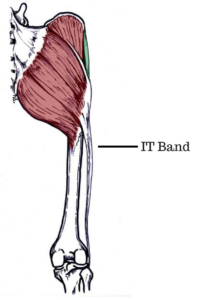 What is the iliotibial band is a question more people should have an answer for because it is the source of so much pain. The iliotibial band is a sheath of connective tissue that runs from just below the ASIS (anterior superior iliac spine) of the pelvis to the top outer portion of the tibia, the larger of the two bones that make up the lower leg. Two muscles connect along the iliotibial band—the tensor fasciae latae, and the gluteus maximus.
What is the iliotibial band is a question more people should have an answer for because it is the source of so much pain. The iliotibial band is a sheath of connective tissue that runs from just below the ASIS (anterior superior iliac spine) of the pelvis to the top outer portion of the tibia, the larger of the two bones that make up the lower leg. Two muscles connect along the iliotibial band—the tensor fasciae latae, and the gluteus maximus.
The fascia lata, which is affected by the muscle I just mentioned, is a wrapping of fascia that envelops the whole thigh, and the iliotibial band is the fascia latae at its thickest points on the outer leg.
The basic function of the iliotibial band as well as the tensor fasciae latae muscle is to flex, abduct, and internally rotate the hip. More importantly, the iliotibial band contributes to stabilizing the knee and is constantly in use during walking and running.
When you hear someone use the phrase tight hips they are referring to a lack of mobility of the leg bone in the hip socket. This lack of mobility is almost always accompanied by a tight tensor fascia latae muscle and a great deal of tension in the iliotibial band.
Later on, if you are walking down the street, look for someone whose knees tend to move out to the side with each step. That person, as well as the person next to you in yoga class (unless that person is you), whose knees are closer to their shoulders then the floor when sitting cross-legged, has a tight iliotibial band.
When the tensor fasciae latae and the iliotibial band are tight and full of tension they create a drag on the whole back of the body often pulling the pelvis into a tucked position and forcing the head forward of the shoulders.
While I think everyone should know anatomy and therefore know the answer to the question what is the iliotibial band, it is even more important for people with tight hips. It is hard to change bad patterns if you dont understand what the pattern is.
While the iliotibial band is supposed to rotate internally i think it rarely does, and it is chronically tight on so many people because the way they stand and move is constantly pulling the iliotibial band into external rotation. Constantly, like 24/7.
A muscle that is greatly affected by this faulty alignment is the second muscle that connects to the iliotibial band, the gluteus maximus. We are a race of tight assed people due in large part to the it band and its alignment. The gluteus maximus is an extensor muscle which means it should pull down on the back of the pelvis in direct opposition to the iliotibial band and the tensor fascia latae which are meant to rotate internally.
The habitual external rotation of the iliotibial band squeezes the ideally broad gluteus maximus into a rock hard orb for those extremely afflicted. It also effects the muscles underlying the gluteus maximus—the internal and external rotators of the pelvis such as the deeper glutes, the piriformis and others.
If the body is compromised in its internal and external rotations, its ability to flex and extend will by necessity be compromised as well.
***
